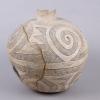
Gallup Black-on-white jar (MMA 47.11.20)
Posted on: Monday, March 22, 2021
This Gallup Black-on-white jar excavated was from the fill of room 3 at Bc59, a small site located on the south side of Chaco Canyon, in July of 1947. Gallup Black-on-white vessels were made for approximately 170 years, from 980 to 1150 A.D. They... read more
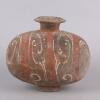
Cocoon-shaped jar, China, Han Dynasty 221 BC-220 AD (MMA 2012.91.60)
Posted on: Monday, March 15, 2021
This painted earthenware likely was a funerary offering in a Han Dynasty tomb, one of a suite of goods that accompanied the deceased into the afterlife. The vessel rests on a raised foot ring and its narrow neck suggest it was meant to held... read more
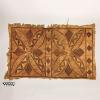
Samoan Tapa Cloth (83.13.1)
Posted on: Monday, March 8, 2021
This tapa cloth, likely made from paper mulberry (Broussonetia papyrifera) bark, was gifted to donor Ira L. Kessler by a Samoan chief in 1943. The cloth’s age is evident by its tattered and fraying edges. The front side of the cloth has a design... read more
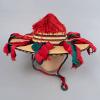
Ribboned hat (lixton pixolal), San Juan Chamula, Chiapas, Mexico (MMA 2018.23.76)
Posted on: Monday, March 1, 2021
This man’s hat, with a flat brim adorned with red and green ribbons and a red tassel on top, is from the township of San Juan Chamula in the Mexican state of Chiapas. It is made from palm fiber, most likely Sabal mexicana, a fan palm species that... read more

Ganado Rug. Artist unknown, ca. 1930. (MMA 63.47.1)
Posted on: Monday, February 22, 2021
This Navajo weaving in the Ganado style features a central motif of stepped hourglass shapes surrounded by terraced zig-zag lines and terraced “v” shapes on the sides in black, white, red, and natural wools. The overall dimensions of the rug are... read more
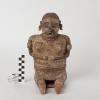
Seated Woman, Lagunillas Style E, Nayarit, Mexico, c. 300 BCE-300 CE, artist unknown (MMA 2006.66.2)
Posted on: Monday, February 15, 2021
With this post, the Maxwell Museum of Anthropology and UNM Art Museum Student Advisory Board (UNMAM SAB) are launching a new online collaboration featuring UNM museum collections and the work of student researchers. Today's post features the work... read more
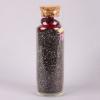
Cochineal insects (2012.178.12a)
Posted on: Monday, February 8, 2021
Cochineal is a magenta-colored dye that is derived from tiny parasitical insects (Dactylopius coccus) indigenous to Mexico, South and Central America, and the American Southwest. Mesoamericans have been cultivating the insects and dyeing with... read more
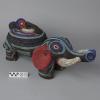
Bamileke elephant box (2019.12.1)
Posted on: Monday, February 1, 2021
This fully-beaded elephant-shaped box with lid was made by the Bamileke people of West Cameroon, Africa. The body and head of the elephant are carved from a solid piece of wood, and covered with beadwork over its entire surface. The beads are... read more
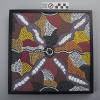
Maku Wichetty Grubs, by Dawn Nipper, ca. 2005
Posted on: Monday, January 25, 2021
This painting on canvas by Australian Aboriginal artist Dawn Nipper is entitled “Maku Wichetty Grubs.” It depicts four bands of purple radiating out from a central black and white circle. Each band has two white grubs with orange dots at their... read more
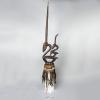
Ci wara headdress (MMA 79.13.1)
Posted on: Monday, January 18, 2021
Art historians consider the ci wara (first documented in print in 1912 by a Frenchman as “Tyi Ouara”) to be the iconic African sculpture. France colonized the region of West Africa now known as Mali (République du Mali) that included the Bamana... read more












